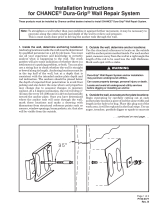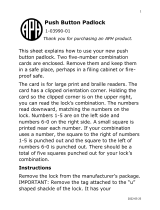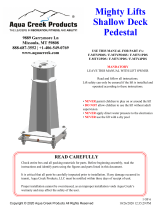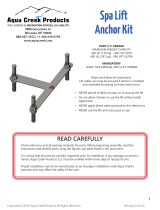
SOUTHWEST WINDPOWER 3-CMLT-1028-02 REV D
SOUTHWEST WINDPOWER Page 1 of 35
WHISPER 42 FOOT (13 Meter) TOWER KIT
for SKYSTREAM 3.7® AND WHISPER 500 WIND TURBINE
Made in the USA by:
SOUTHWEST WINDPOWER, INC.
1801 Route 66
Flagstaff, AZ 86001
(928) 779-9463

SOUTHWEST WINDPOWER 3-CMLT-1028-02 REV D
SOUTHWEST WINDPOWER Page 2 of 35
Please read this manual thoroughly before beginning assembly. If you have any questions
on proper installation or usage please call either Southwest Windpower or your dealer for more
information.
TABLE OF CONTENTS
CONTENTS Page
TABLE OF CONTENTS ............................................................................................................. 2
Introduction ................................................................................................................................ 3
Safe Installation ......................................................................................................................... 4
Tower Kit Parts List.................................................................................................................... 5
Unpacking, Inspection and Approval.......................................................................................... 7
Step 1: Site Selection............................................................................................................. 8
Step 2: Mast Pipe and Hardware Selection ........................................................................... 8
Step 3: Tower, Base and Anchor Layout ............................................................................. 13
Step 4: Tower Base & Guy Wire Anchor Assembly ............................................................. 21
Step 5: Assembly of Pipe sections....................................................................................... 22
Step 6: Attaching Guy Wires ................................................................................................ 23
Step 7: Grounding the Tower ............................................................................................... 28
Step 8: Raising the Tower.................................................................................................... 28

SOUTHWEST WINDPOWER 3-CMLT-1028-02 REV D
SOUTHWEST WINDPOWER Page 3 of 35
Introduction
This tower kit is designed specifically for the Southwest Windpower Skystream 3.7® and
Whisper 500 wind turbine. To our knowledge this is the most economical and user-friendly
tower kit available for the Skystream 3.7® and Whisper 500 wind turbine. The tower kits are
designed to use guy wires, allowing the use of schedule 40 pipe while providing adequate
strength, even in high wind conditions. At least two people should be present to safely raise the
tower.
Carefully read and understand the disclaimer at the beginning. While simple in concept these
towers require basic mechanical aptitude and attention to detail. Read the system planning
section of the Owners Manual and determine the location for the tower. It is much easier to work
with nearly level ground. Parts listed to construct these towers are readily available in most parts
of the world.
Thank you for purchasing our products and for your interest in renewable energy. We expect
that you will enjoy the benefits of your wind powered electrical system for many years to come.
If, after reading this manual, you have any further questions please contact your local dealer or
Southwest Windpower and we will do our best to assist you.
NOTE:
Skystream 3.7® Tower Adaptor is not included in this kit.
Please purchase separately.
PART # 2-TWS-100

SOUTHWEST WINDPOWER 3-CMLT-1028-02 REV D
SOUTHWEST WINDPOWER Page 4 of 35
Safe Installation
Safety is the most important consideration to take into account when installing a tower
and wind turbine. It is very important to remember that any wind turbine has high speed
spinning parts and can be very dangerous if not installed properly! Make sure that the Schedule
40 steel pipe used for the tower is of adequate strength, that all bolted connections are tight and
the guy wire anchors are suitable for your soil conditions. All of these elements are explained in
further detail later in this manual. Important! Choose a very calm day to do your
installation. A gust of wind at the wrong moment could cause A VERY SERIOUS
ACCIDENT!
PLEASE….READ ALL OF THIS MANUAL BEFORE DOING ANYTHING !

SOUTHWEST WINDPOWER 3-CMLT-1028-02 REV D
SOUTHWEST WINDPOWER Page 5 of 35
Tower Kit Parts List
GP3-13K4 (42 Ft/ 13 m)
Your tower kit includes:
QUANTITY PART NO. PART DESCRIPTION
2 3-CMBP-1334 BASE PLATE
4 3-CMBP-1268-01 GUY TAB-PUNCHED (30°) (3 Holes - For Tower)
2 3-CMBP-1268-02 GUY TAB-PUNCHED (45°) (2 Holes - For Gin-Pole)
1 3-CMBP-1265 LINK—GIN POLE TO 1 TURNBUCKLE
2 3-CMBP-1266 LINK—GIN POLE TO ANCHOR EYEBOLT
5 3-HDBT-1005-407 SIDE GUY TAB BOLT -- 5/8 - 11 X 7 ½” GR5 ZINC
3 3-HDBT-1005-408 HEX HEAD BOLT--7/8-9 X 8 GR 5 ZINC
1 3-HDBT-1005-395 HEX HEAD BOLT -- 7/8-9 X 3 GR 5 ZINC
5 3-HDNT-103-21 NYLOCK HEX NUT--5/8-11 GR 5 ZINC
4 3-HDNT-103-25 NYLOCK HEX NUT--7/8-9 GR 5 ZINC
4 3-HDBT-9002 ANCHOR BOLT FOR BASE ANGLES--3/4 X 18 GALVANIZED
4 3-HDWA-103-15 ¾” SPLIT LOCK WASHER FOR BASE ANCHOR BOLTS
12 3-CAOT-1208-06 THIMBLE --5/16 HEAVY DUTY
44 3-CAOT-1209-05 WIRE ROPE CLIP --5/16 DROP FORGED STEEL
4 3-CAOT-1102 TURNBUCKLE – 5/8 X 9 EYE & AJW DROP FORGED
300 3-CAOT-1207-08 GUY WIRE--5/16”
2 3-CMBP-1269 TUBE SPACER FOR BASE ANGLE LOCATION
3 3-CAOT-1115 SHACKLE--2 TON, SIZE ½”
3 3-CMBP-1323 TOWER COUPLER
27 3-HDBT-1020-246 ½” - 13 X 1 ½” CARRIAGE BOLT
27 3-HDNT-103-17 ½” - 13 X 1 ½” NUT
27 3-HDWA-106-12 ½” FLAT WASHER
Items NOT Included in This Kit:
Description Quantity
Tower Adaptor (2-TWS-100) (for Skystream 3.7 install only) 1
5” Schedule 40 Steel Pipe 3 x 21’ (6.4m)
¾” x 12 inch Forged eyebolt for anchor 2
¾” x 8 inch Forged eyebolt for anchor 2
Copper ground rod 1
Ground Wire 10 ft
Rope for tower lift line (8000 lbs min. breaking strength) 60 ft
Rope for gin pole lift line & ladder side support 130 ft
(4000 lbs min. breaking strength)
Pulley for tower lift line (min. 4500 lbs rating) 1
Pulley for gin pole lift line (min. 3000 lbs rating) 1

SOUTHWEST WINDPOWER 3-CMLT-1028-02 REV D
SOUTHWEST WINDPOWER Page 6 of 35
Description Quantity
10 ft ladder rated for 250lbs 1
Concrete (2500 psi rating) 4.5 yd3(0.9/anchor)
Rebar –various sizes and lengths. See Anchor Details
Wood blocks, bricks to lift pipe 7” above ground level
Sledgehammer
Heavy duty ½” drill
Heavy-duty leather gloves
Safety glasses
Grease to slide pipe inserts into place
Metal file to remove excess metal on pipe edges

SOUTHWEST WINDPOWER 3-CMLT-1028-02 REV D
SOUTHWEST WINDPOWER Page 7 of 35
Unpacking, Inspection and Approval
1. Inspect the parts included in your tower kit and make sure that nothing is missing or
damaged. Use the Parts List for assistance identifying parts as you unpack your kit.
2. Parts NOT included in the Tower Kit must be procured locally, and should be available at
a hardware store. Pipe for the tower can be purchased from a local plumbing or steel
supplier. Southwest Windpower can help you find sources for lift lines, pulleys, and
anchor eyebolts.
Refer to the Parts List to determine the total length and number of pipes required for the
tower itself and the lift pipe (ginpole). Make sure your materials supplier cuts the pipes to
the appropriate length BEFORE you have them delivered to your site! The kit will require
drilling holes on the pipe.
You also need to decide if you will be lifting the tower by vehicle or winch, and obtain the
necessary equipment and components. An appropriately sized winch can be used
instead of a vehicle and pulley system.
3. This tower kit has been reviewed for tower stress and anchor load analysis per the 1997
Uniform Building Code (UBC) for static analysis only. A registered professional engineer
who is licensed to practice in the States of Nebraska and California did the analysis. For
counties that require a building permit, request PE Stamped Engineering approved tower
and foundation plans (Nebraska, California) from Southwest Windpower. Submit the
engineer-approved tower and foundation plans to your local building permit authorities
and obtain a building permit.
4. Before installation, clean, prime and paint all parts including the base angles furnished in
the kit. In particularly corrosive environments you may wish to consider having parts hot-
dipped galvanized. Hardware (nut, bolts, turnbuckles, guy wire, etc.) furnished by
Southwest Windpower in the tower kits are galvanized for corrosion resistance.

SOUTHWEST WINDPOWER 3-CMLT-1028-02 REV D
SOUTHWEST WINDPOWER Page 8 of 35
Step 1: Site Selection
Site selection is the most important factor affecting the performance of your wind turbine!
The energy in the wind is the kinetic energy of the moving air mass. What a wind turbine does is
convert some of that kinetic energy into mechanical energy, which is then converted to
electricity. The formula for the amount of power in the wind is a cube function of the wind speed.
This means basically that an increase in wind speed of 10% (say from 9 mph to 10 mph) will
result in approximately a 37% increase in the energy available from the wind and a similar
difference in turbine performance. In almost all locations the wind speed increases, as you get
higher off the ground. This is why the taller the tower the better. As a rule, the turbine should be
mounted as high in the air and as far away from obstructions as is possible.
To find the best location to erect your tower and wind turbine, study the area available and take
note of how the prevailing (most common) winds blow through it. If there are trees, buildings,
hills or other obstructions take note of how high they are and where they are in relation to the
prevailing wind direction and your proposed tower location. The best site for your tower and
turbine will be upwind and above any obstructions which may exist. If there are houses or trees
in the surrounding area it is best to mount the turbine at least twice as high as any obstruction in
the area. If the turbine is to be mounted at the crest of a hill or on a beach where winds come
from across the water, a lower tower may be acceptable.
The next consideration in siting your tower and turbine is the distance from the turbine to your
batteries. The shortest distance will require the least amount of wire and reduce the amount of
power lost through the wiring. If a long distance is required between your tower and the
batteries it will be necessary to use heavy gage wire to reduce the resistance of the wire. The
power consumed by the wires can be calculated using the formula:
Power = Current x Current x Resistance (P=I2R)
Since the resistance of the wire is directly proportional to its length, making the run shorter will
dramatically reduce the amount of power “lost” in the wires. Refer to the Whisper Owner’s
manual and make sure you are using correct gage wiring to minimize system losses. The
person laying out your power system should be aware of these considerations when the system
is in the planning stages.
Step 2: Mast Pipe and Hardware Selection
Due to the high cost of shipping and the widespread availability of pipe used for the tower,
Southwest Windpower does not provide these materials. Materials are readily available through
most hardware stores or plumbing companies and will cost much less when purchased locally
than if they were shipped from our factory.
The Skystream 3.7® and Whisper 500 is designed to be mounted on a 5” inside diameter pipe
(12.7 cm). The pipe is classified as 5” Schedule 40 steel pipe. Around the world pipe may come
in different sizes. Make sure your pipe is Schedule 40 with a wall thickness of 0.258” (6.5 mm),
and an external diameter of 5.563” (14.1 cm).
NOTE: In some areas there are subsidies and grants available for installing renewable energy
systems. If you live in one of these areas and need an engineering analysis for this tower

SOUTHWEST WINDPOWER 3-CMLT-1028-02 REV D
SOUTHWEST WINDPOWER Page 9 of 35
assembly to satisfy your local authorities please contact us. We have an engineering analysis
available for this tower kit.
Pipe Length Table for 5 inch Schedule 40 Pipe 42Ft(13m) Tower (See Figure 1)
No. Parts Tower Part Description Length ft(meters)
1 Lift-Pipe (horiz.) Gin Pole 21ft (6.4m)
1 Tower (vertical) Pipe attached to Base 21ft (6.4m)
1 Tower (vertical) Pipe attached to Turbine 21ft (6.4m)
Figure 1 describes the way the different pipe lengths are assembled.

SOUTHWEST WINDPOWER 3-CMLT-1028-02 REV D
SOUTHWEST WINDPOWER Page 10 of 35
See Fig 1.1
Steel Pipe Used: 5 inch
Schedule 40
See Fig 1.2
Guy Wire
GP3-13K4L (42ft [13m])
Figure 1: Tower Layout

SOUTHWEST WINDPOWER 3-CMLT-1028-02 REV D
SOUTHWEST WINDPOWER Page 11 of 35
Figure 1.2

SOUTHWEST WINDPOWER 3-CMLT-1028-02 REV D
SOUTHWEST WINDPOWER Page 12 of 35
Back Anchor 4"
Above Ground
Level, eyebolt flush
to ground
Lift-Pole (Gin Pole)
Anchor 4" Above
Ground Level,
eyebolt flush with
cement
Lift Pole (Gin Pole)
Side Guy Wires
Lift Pole (Gin Pole)
Side Guy Wires
Back Guy wire
Figure 2: Birdseye View

SOUTHWEST WINDPOWER 3-CMLT-1028-02 REV D
SOUTHWEST WINDPOWER Page 13 of 35
Isometric View
Figure 2: Anchor and cable layout
Step 3: Tower, Base and Anchor Layout
This tower kit must only be erected on a calm day (no wind). The tower base and anchors
should be laid out as described in Figure 2 and Figure 7. The tower will be assembled laying
on the ground and then tilted up into position.
IMPORTANT!
If the tower is being erected on the side of a hill it will be much easier to raise the tower if it is
Carefully study Figure 2 and Figure 7 to help you determine how much space you
will need to raise your tower, which is pulled up from the lift anchor. Be especially
aware that the concrete anchors are 4 inches above ground level. The lift anchor is
slightly off-center (3-4 inches) in order to be assembled with the metal links. Keep
both things in mind while you dig and build your concrete anchors.

SOUTHWEST WINDPOWER 3-CMLT-1028-02 REV D
SOUTHWEST WINDPOWER Page 14 of 35
assembled to the uphill side of the base, as it will already be part way
up once it is assembled. In this case the two opposing anchors should be at the same height on
the hill as the tower base, one anchor should be directly uphill and one directly downhill from the
tower base. The ground must be level or made level between the side anchors and the tower
base. The ground may slope steadily downward from the tower top (when it is in the lowered
position) to the tower base, and from the tower base to the lift anchor. When the lift anchor lies
lower than the tower base there is more room for winches, lifting pulleys, etc.
Be sure the anchor points and base position are in a line when sighted from anchor to anchor. It
is very important that the center of the eyebolts on the side anchors are in line with the center
pivot bolthole on the base angles. This means that the center of the eyebolts on the side
anchors should be 6 inches above the top of the 4-inch concrete anchors for a total distance of
10 inches above the ground (see Figure 4.3). This must correspond with a base anchor that is 6
inches above ground level because the hole in the angles is 4 inches above the concrete for a
total distance of 10 inches above ground (see Figure 2). This will ensure that the forces on the
guy wires are balanced properly, make final guy wire adjustments simpler and will help a great
deal during the actual raising of the tower. The side anchors and tower base should also be at
the same height. If either of these requirements are not met, the guy wires will either tighten
excessively or become excessively slack as the tower is raised. If the guy wires tighten
excessively the tower may buckle and collapse, causing possible injury or even death
and at the very least, damage to both the tower and the turbine. Carefully read the
section on raising the tower for further instructions on making the proper adjustments in
these situations.
A tower should never be close to occupied buildings. A good rule of thumb is to select a location
that is a distance of at least one and a half times the tower height. Thus, if you are installing a
42’ (13 m) tower, the tower should be a distance of at least 63 feet (19.5 m) from any occupied
buildings.
CAUTION!
NEVER INSTALL A TOWER WHERE IT COULD CONTACT POWERLINES IN ANY
DIRECTION.
DANGER OF LETHAL SHOCK!
CONTACT WITH OVERHEAD POWER LINES WILL CAUSE INSTANT ELECTROCUTION
These towers may often be set in wooded areas. It is only necessary to clear enough trees for
the guy wires. Clear the path for the guy wires as the tower is raised and lowered. Be sure the
height of the tower is at least 30 ft (10 m) above trees and structures within 300 ft. (100 m)
radius of the wind generator. The center of an open field is ideal and can reduce the tower
height requirement.
Determine Location for Tower Base
Select a location for the tower base, and determine the direction in which the tower will lower
and raise. If you will be using a vehicle to raise the tower, clear a path for the lift line from the lift
anchor to the vehicle. A swivel pulley will be installed at the lift anchor, between the tower base
and the vehicle. Mark the ground locations for the base and anchors.
This tower kit is designed for installation on a flat surface. If you have a location that is on an
incline or side of a hill you will need to have a local certified engineer review your installation.
The design of this tower requires the gin pole (lift pipe) to rest on the eyebolt/anchor. If the gin

SOUTHWEST WINDPOWER 3-CMLT-1028-02 REV D
SOUTHWEST WINDPOWER Page 15 of 35
pole was not supported from the ground it would cause unnecessary stresses and could force
the tower to buckle. In addition, on an incline, your upper anchor should be installed on a
dugout in order to make sure enough dirt is actually supporting the stresses of the anchor. If
you are unsure of your design, and before you begin your project on a hill, we recommend you
contact the head engineer at Southwest Windpower to make sure your installation is safe.
When your tower is being installed on an incline you must make sure that the side anchors and
base anchor are level. The front and back anchors must be directly up and down slope with the
gin pole on the downhill section. This will help raise the tower since the turbine will be resting
uphill. Make sure the anchor points and base anchor are in line when sighted from anchor to
anchor. This will ensure the forces on the guy wires are balanced properly.
Isometric View

SOUTHWEST WINDPOWER 3-CMLT-1028-02 REV D
SOUTHWEST WINDPOWER Page 16 of 35
Side View
Figure 3.1: Base Anchor Layout
Figure 3.2: Base Anchor Detail View

SOUTHWEST WINDPOWER 3-CMLT-1028-02 REV D
SOUTHWEST WINDPOWER Page 17 of 35
Figure 4.1: Lift-Pipe Anchor Angle View
Drawing Not to
Scale
Figure 4.2: Side View of Lift-Pipe Anchor (Eyebolt Flush with Concrete)

SOUTHWEST WINDPOWER 3-CMLT-1028-02 REV D
SOUTHWEST WINDPOWER Page 18 of 35
Cement
Anchor
516" safety
cable - 5ft
aprox length
Cable clamps
Drawing NOT TO
SCALE
Figure 4.3: Above Ground Concrete Anchor View (back and side anchors only)

SOUTHWEST WINDPOWER 3-CMLT-1028-02 REV D
SOUTHWEST WINDPOWER Page 19 of 35
Figure 5: Tower Foundation Detail

SOUTHWEST WINDPOWER 3-CMLT-1028-02 REV D
SOUTHWEST WINDPOWER Page 20 of 35
Figure 6: Anchor Foundation Detail
Page is loading ...
Page is loading ...
Page is loading ...
Page is loading ...
Page is loading ...
Page is loading ...
Page is loading ...
Page is loading ...
Page is loading ...
Page is loading ...
Page is loading ...
Page is loading ...
Page is loading ...
Page is loading ...
Page is loading ...
-
 1
1
-
 2
2
-
 3
3
-
 4
4
-
 5
5
-
 6
6
-
 7
7
-
 8
8
-
 9
9
-
 10
10
-
 11
11
-
 12
12
-
 13
13
-
 14
14
-
 15
15
-
 16
16
-
 17
17
-
 18
18
-
 19
19
-
 20
20
-
 21
21
-
 22
22
-
 23
23
-
 24
24
-
 25
25
-
 26
26
-
 27
27
-
 28
28
-
 29
29
-
 30
30
-
 31
31
-
 32
32
-
 33
33
-
 34
34
-
 35
35
Southwest Windpower GP3-13K4L User manual
- Type
- User manual
- This manual is also suitable for
Ask a question and I''ll find the answer in the document
Finding information in a document is now easier with AI
Related papers
Other documents
-
Chief FCS1U Installation guide
-
 Chance Foundation Solutions Dura-Grip Wall Repair System (P150-0377) Installation guide
Chance Foundation Solutions Dura-Grip Wall Repair System (P150-0377) Installation guide
-
 Primus Windpower 1-AR40CP-KIT-12 Owner's manual
Primus Windpower 1-AR40CP-KIT-12 Owner's manual
-
 APH 1-03990-01 Operating instructions
APH 1-03990-01 Operating instructions
-
FieryRed TOW1 User manual
-
 Tumo-Int 3000W 5 Blades Wind Turbine User manual
Tumo-Int 3000W 5 Blades Wind Turbine User manual
-
 Aqua Creek Mighty Pedestal, Shallow Anchor User manual
Aqua Creek Mighty Pedestal, Shallow Anchor User manual
-
Bushranger RRK12 Owner's manual
-
Bushranger RRK12 Owner's manual
-
 Aqua Creek F-SPAAK8 Operating instructions
Aqua Creek F-SPAAK8 Operating instructions











































